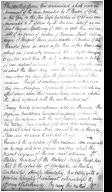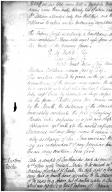[ The Method of Cure with Dr. Burton's Recipe ] Dr. William James Almon
Date: Published in 1738.
Source:
Manuscript Notebook of Dr. William James Almon
Institution: Nova Scotia Archives
| Source Origin: Almon Family Fonds
| Reference: MG 1 / Microfilm Reel 10,045
Detailed recommendations and medicines, including a Latin prescription, on treating whooping cough, pp. 233-34. The method claims to be an improvement on that forwarded by Dr. John Burton in an essay on the "chin-cough" appended to his book, A Treatise on the Non-Naturals (A. Staples: London, 1738).
The method of cure here recommended which is an im
-provement of the mode prescribed by Dr. Burton of York
in his Essay on the Chin Cough published in 1738 was com
-municated to Dr. Lettsom by W. Abraham Sutcliff, an emi-
-nent Surgeon-Apothecary of Settle, in York-Shire, and con-
-sists of six ounces of Tincture of Peruvian Bark, half an
ounce of Paregoric Elixir, and a drachm or Tincture of Can-
-thanides, given in small doses, three or four times a day,
which are gradually increased, till a slight strangury
is excited, and then the dose is diminished, or taken
at more distant intervals. The strangury usually comes
on about the third day; and the hooping seldom conti-
-nues above six days from the first exhibition of this
medicine. Though it sometimes succeeds without exci-
-ting any strangury, it generally produces its salutary
effect sooner, when that circumstance comes on, whether
the bark is joined with the Cantharides or not.
During twenty years experience | adds our Physician | this
Ingenious practitioner has almost uniformly continued the
use of this medicine with the most flattering success; under
his tutelage I was a witness of it; and from numerous
instances which have since occurred to me in this city,
I have seen no reason to interdict its use.
Previous to the exhibition of this medicine some evacuati-
-on he says will be in general necessary, which the
present exigencies of the case must determine. Dr.
Millar President of the Medical Society, though par-
tial to the exhibition of Assafotida, as thinking
Cantharides, strongly stimulating, has lately, with a
peculiar liberality of sentiment, acknowledged the
efficacy of Cantharides. By using this method W.
Sutcliff we are told never lost a pertussile patient and
among more than sixty, twenty two of whose cases he relates
Dr. Lettsom attended only two that died, and they evidently
appeared to expire under pulmonary symptoms.
__________________________________
The Hooping Cough is certainly a troublesome and dange-
-rous complaint. I have seen most use from a particu-
-lar emetic of the following form
Rx Aq: Distill: ℥ij
Tinc: Vitriol gr. x
Sulph. Aurat. Antim. gr. viij Misce fiat
Mistura. cochleare minim. / vel ij ad iij__
This mixture should be given as the age, strength, and
Circumstances of the disease may require; the dose should
be so regulated as to keep up a constant Nausea; the
body kept loose by Calomel in large doses, & food
in the form of Broths given per anum in preferrence
by the Mouth, the distension of the stomach does
undoubtedly accelerate the fits of Coughing; a Pitch
Plaister inter scapulas is a good and slight irritating
application, yet with all the united influence of
Medicines not any thing seems to relieve so effectu-
-ally as change of Air. I am convinced that chang
-ing air independent of any peculiar properties
the air may contain, does good.
MARGIN:
Dr. Burton’s
Recipe
Take a scruple of Cantharides and as much camphire
W.cs when well mixed. I order to be mixed w.th three
drachms of extract of Bark, the dose eight or ten grains
every third or fourth hour, according to the circumstances
of the cases, in a spoon-ful of simple water or julep, in
which was dissolved a light balsam of Copaiba.
Translation (from second image, lines 8-11)
Recipe: 2 ounces of distilled water
10 grains elixir of vitriol
8 grains of Gold Sulphuratum Aureum. Mix. Let a mixture be made. A very small spoonful, or 2 to 3.
Translation and transcription by Winston Black
Download: Transcription | Images

